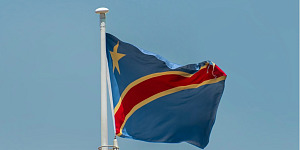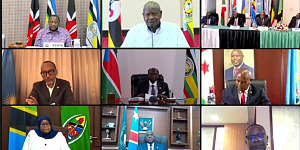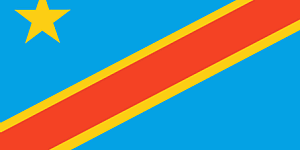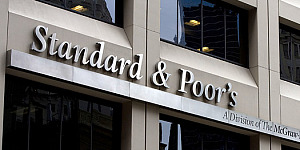 Moody's Investors Service has assigned local- and foreign-currency issuer ratings of B3 to the government of the Democratic Republic of the Congo (DRC). The ratings have a stable outlook.
Moody's Investors Service has assigned local- and foreign-currency issuer ratings of B3 to the government of the Democratic Republic of the Congo (DRC). The ratings have a stable outlook.
The main drivers of DRC's B3 issuer ratings are:
1. The fragile economy, albeit with robust growth prospects given the large foreign investment in the mining sector;
2. Very weak institutional strength, although indicators have gradually improved over the past 10 years;
3. Weak fiscal fundamentals despite multilateral debt forgiveness in 2010;
4. Elevated vulnerability to economic and political risks, arising from its relatively limited fiscal and foreign-exchange reserves, growing regional economic disparities and recurrent instability in the east of the country.
RATINGS RATIONALE
--FRAGILE ECONOMY WITH ROBUST GROWTH POTENTIAL—
Moody's decision to assign the B3 sovereign isssuer ratings to the DRC primarily reflects the fragility of the country's economy and the very low per capita incomes relative to its rated peers, which are offset by the robust growth prospects driven by the significant foreign investment in the DRC's mining sector and the expected rise in domestic consumption as the economy recovers from the civil wars of the past two decades. Moody's expects economic growth to average 8% over the next few years, which is 2% above the average rate posted over the past 10 years.
--VERY WEAK INSTITUTIONAL STRENGTH—
The second driver underpinning Moody's B3 sovereign ratings for the DRC is the country's very weak institutional strength, as evidenced by its low rankings on many international surveys, including the World Bank's governance indicators. That being said, these indicators have been gradually improving over the past 10 years, thanks partly to the full implementation of numerous reform programs until 2010 with the help of the Heavily Indebted Poor Country (HIPC) initiative, which in turn led to the Paris Club's decision to cancel most of the DRC's external debt. The authorities have also embarked on a series of reforms to enhance transparency and improve the business climate, including the DRC's commitments to both the Extractive Industries Transparency Initiative and the Organisation for the Harmonisation of Business Law in Africa.
--WEAK FISCAL FUNDAMENTALS—
Despite bilateral and multilateral debt forgiveness in 2010, the DRC's fiscal fundamentals are weak and represent the third driver informing Moody's assignment of the B3 sovereign ratings. The weak metrics are reflected by the government's decision to voluntarily restrict its fiscal spending to minimize its fiscal deficit, given that there is virtually no domestic capital market and deficits have historically led to macroeconomic volatility in the country. However, the DRC's tax performance has improved over the past 10 years, with revenue as a percentage of GDP rising to 21% by year-end 2012 from 5% in 2000, despite strong nominal economic growth. With the introduction of VAT in 2012 and likely stronger mining-related revenue over the next few years, the government should be able to achieve its objective of strengthening public finances. Assuming that global commodity prices remain stable and there is no extraordinary spending due to further instability in the country's eastern regions, Moody's expects the DRC's fiscal situation to improve in 2013-14 and its debt metrics to remain in line with B-rated peers.
--ELEVATED VULNERABILITY TO ECONOMIC AND POLITICAL SHOCKS—
The fourth driver of the B3 rating is the country's elevated vulnerability to economic and political risks. The economy's vulnerability to external shocks was illustrated during the 2009 global financial crisis when commodity prices tumbled and foreign direct investment dried up. At the end of February 2013, foreign-exchange reserves were $1.7 billion, sufficient to cover only 2.3 months of imports, which is low compared with other countries, especially commodity exporters. The authorities are targeting six months' import cover by 2018, as well as the major goal of achieving the foreign-exchange objectives set by the Southern Africa Development Community (SADC) and the Common Market for Eastern and Southern Africa (COMESA). Given the high level of investment in the country, particularly in the mining sector, this objective is likely to be met in the absence of another major crisis.
The country's vulnerability to political risk reflects the recurring instability associated with civil wars since the early 1990s in the east of the country. Although the conflict's intensity has eased since the 2002 peace agreement, rebel groups continue to destabilise the country in attempts to gain control over the country's resources, especially in North and South Kivu, where there are substantial deposits of coltan. It is important to note that the international community's commitment to tackling the persistent instability in the DRC's great lakes area, either at the level of regional bodies such as the African Union or the UN -- the most tangible example being the dispatch of UN forces in 2001 to help fight rebel forces. The international community is also putting pressure on neighbouring African countries to contribute to the creation and maintenance of stability in the great lakes area. As a result, Moody's attaches a low likelihood to a return to hostilities on the scale of those experienced in the 1990s, although the east of the DRC remains exposed to instability.
RATIONALE FOR STABLE OUTLOOK
The stable outlook on the DRC's B3 issuer ratings reflects Moody's expectation of continued strong economic growth as the mining sector continues to develop and an improvement in the government's financial position. These factors are balanced by the country's elevated financing needs to rebuild infrastructure and the need to implement further structural reforms. The stable outlook also reflects Moody's expectations that debt and external buffers will grow moderately.
WHAT COULD MOVE THE RATINGS UP/DOWN
Moody's believes that positive rating pressure could develop in the event of (1) continued foreign investment in the mining sector, leading to much stronger commodity revenues in the budget; (2) an increase in foreign-exchange reserves and fiscal buffers to smooth any negative impact of external shocks on the economy; (3) continued strengthening of institutional weakness, which is a long-term constraint on the ratings; (4) accelerated fiscal reforms, including state-owned enterprises as well as fuel and energy subsidies; and (5) continued capital expenditure to finance the rehabilitation of the country's infrastructure, particularly with respect to power generation and its transport network.
Downward pressure on the rating could arise from factors that include (1) a sustained decline in the prices of the main commodities exported by the DRC; (2) a rapid depreciation of the Congolese franc which could drain foreign-exchange reserves through central bank intervention, making the economy and the government more vulnerable to further external shocks; (3) a large deterioration of the government's fiscal balance that leads to macroeconomic imbalance and volatility; and (4) an intensification, albeit currently unlikely, of the instability in the east of the country.
COUNTRY CEILINGS
As part of the assignment of sovereign ratings for DRC, Moody's has today also set the following ceilings for domestically based issuers of corporate and structured ratings:
Foreign-currency bond ceiling: B2
Foreign-currency deposit ceiling: Caa1
Local-currency country risk bond and deposit ceilings: B2
The local-currency country ceilings of B2 reflects the maximum credit rating achievable in local currency for a debt issuer domiciled, or a deposit in a bank, in the DRC. The ceilings on foreign-currency bonds and bank deposits capture foreign-currency transfer and convertibility risks.
GDP per capita (PPP basis, US$): 422.2 (2012 Actual) (also known as Per Capita Income)
Real GDP growth (% change): 7.2 (2012 Actual) (also known as GDP Growth)
Inflation Rate (CPI, % change Dec/Dec): 5.7 (2012 Actual)
Gen. Gov. Financial Balance/GDP: -0.1 (2012 Actual) (also known as Fiscal Balance)
Current Account Balance/GDP: -0.3 (2012 Actual) (also known as External Balance)
External debt/GDP: 40.5 (2012 Actual)
Level of economic development: Very Low level of economic resilience
Default history: At least one default event (on bonds and/or loans) has been recorded since 1983.
On 23 August 2013, a rating committee was called to discuss the rating of the Democratic Republic of the Congo, Government of. The main points raised during the discussion were: The issuer's economic fundamentals, including its economic strength, have materially increased. The issuer's institutional strength/framework, have materially increased. The issuer's fiscal or financial strength, including its debt profile, has not materially changed. The issuer's susceptibility to event risks has not materially changed.
Source: Moody's








































